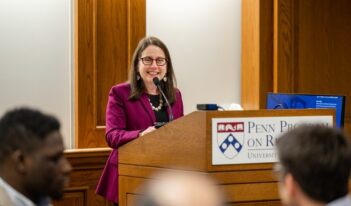
Recent efforts to promote agile governance have deep roots in American pragmatism.
Transferring the principles of agile management to the government context requires some adjustment and orientation. As Stephen Denning explains in his book, The Age of Agile, agile management—or Agile, for short—is not simply a new process; it is a new mindset.
Agile emphasizes small teams, networking, customer orientation and, above all, flexibility and experimentation. These are qualities that can be readily understood in the corporate sector, but they are not familiar or instinctive in the government sector where formality and structure often override creativity and experimentation. But the values that Agile thinking can bring to government are so transformative that it must be explained in a way that wins over skeptics, who are many in the “entrenched” bureaucracy. One way to do this is by showing that Agile is really not the next new thing but rather it is a way of thinking and behaving that has deep roots in both the theory and practice of government.
For me, this means connecting Agile to pragmatism.
Pragmatism is an original American philosophy created by William James and John Dewey in the late Nineteenth century and practiced throughout the Twentieth, notably through the judicial opinions of the great Justice Oliver Wendell Holmes and almost as great followers such as Judge Richard Posner and Justice Sandra Day O’Connor. But it also has meaning for the bureaucracy as expressed by public administration scholars such as Louis Brownlow.
James modestly said that pragmatism was not a philosophy, but a process for making ideas clear. Conclusions were to be reached only through “community knowledge,” not formal logic from on high.
Dewey extolled “the virtue of experimentation” and “learning by doing” as the goals of pragmatism.
Holmes, of course, famously said, that “the life of the law is not logic, but experience.” In doing so, he connected the law directly to the pragmatic movement and challenged his judicial colleagues who relied only on formalistic logic to decide cases.
The debate over formalism is still going on at the Supreme Court, but today it is reflected in the fight over originalism and the power of its logic. Judge Posner, from his pragmatic perspective, sees theories such as originalism as tools for making decisions, not as controlling ideas. Justice O’Connor, similarly, developed a case-by-case approach to decision-making that eschewed weighty theories and reflected what would today be considered Agile thinking.
Agile does have a role to play on the judicial side of government. But its real strength lies in public management and policymaking. Much like Charles Lindblom’s “muddling through,” which brought the concepts of incrementalism and bounded rationality to government management, Agile requires an open mind, flexibility and humility.
Agile’s humility comes from its customer focus, which readily admits that the government does not have all the answers and needs advice from those affected by policy. This is the same thing as the community knowledge which William James insisted upon for pragmatism. The key in both instances was to test ideas in the public arena.
I wondered whether my connection of Agile and pragmatism might have crossed the mind of Stephen Denning, so I checked his book for a reference to pragmatism. But I came up empty. I did, however, find in Chapter 11 of the book the following quotation from John Dewey: “The future cannot be logically deduced from the past.”
Agile is thus “formally” connected to pragmatism, and Denning is a pragmatist whether he knows it or not. Dewey’s admonition is well to keep in mind, because the future is fast upon us.
Many government agencies are using Agile to great effectiveness as other commentators in this series show. The demands on government have never been greater than they are today. Government lacks the capacity to deal with them. This is why Agile is essential today.
It is hard to overstate the demands that were placed on the Inspectors General and other federal officials who must audit over $5 trillion in pandemic relief provided under the CARES Act and American Rescue Plan Act. But by using Agile auditing techniques—such as “flash audits”—and applying artificial intelligence to vast numbers of data sets, the Pandemic Response Accountability Committee (PRAC) has been able to deliver analytic and investigative support across the oversight community. The PRAC is connected to the Pandemic Analytics Center of Excellence where Agile learning and skill building are made available throughout government.
In the face of unprecedented demands, governmental capacity is a problem that only Agile principles can address adequately.
Much of Agile management often involves workarounds from formal or established processes or what to some might be viewed as cutting corners. This can upset members of the public and even traditional bureaucrats. This is why Agile’s commitment to visible workflows, parallel processing, and collaborative decision-making is so important.
Public—or customer—awareness is a big part of what is needed, but the definition of “customer” must include other branches of government too. Congress needs to be made aware of the challenges facing government officials, such as those posed by the PRAC. In this difficult political environment, the tendency is for members of Congress instinctively to criticize the bureaucracy.
As to the courts, a similar critique of workarounds and corner-cutting must be anticipated. This is why Agile regulation, which is subject to judicial review, is harder to achieve than Agile public management more generally. This is especially true when Agile might appropriately involve cutting red tape.
Corner-cutting might run afoul of the “square corners doctrine” created by the pragmatic Justice Holmes, who said that people “must turn square corners when they deal with government.”
But is no longer just that members of the public must carefully follow the rules and procedures laid down by government. Recently, Chief Justice Roberts noted that the square corners doctrine also applies to government agencies. As Roberts explained, “it is also true, particularly when so much is at stake, that ‘the government should turn square corners when dealing with the people.’”
In the end, Agile in the public sector has to take into account not just engineering and efficiency principles. It must also consider formal judicial ones. The courts need a dose of James’s and Holmes’s pragmatism in order to recognize that workarounds, like bounded rationality, have a productive role to play in public administration and administrative law.
This essay is part of a five-part series entitled, Agile Regulation in a Changing World.




